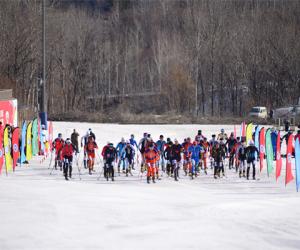History
A large proportion of the rock in the southwest region of the Middle Kingdom is karst, and this area is just beginning to reveal its amazing climbing potential. The caves and arches of Getu He (Getu River) provide the kind of climbing that is similar to what can be found in Yangshuo – in the neighboring province of Guangxi – as well as in Thailand, Vietnam and, a bit further, Cuba's famous "Mogotes" in the valley of Vinales.

Chuanshang cave. Photo Petzl © G. Vallot
In the 1990s, the provincial government of Guizhou decided to protect the Getu area. They created a park with trails signage and stairwaysthat is conveniently located off a paved road.
In the village there is a family known as the Spidermen who once specialized in an acrobatic harvest of swallows' nests. They have secured a license to hold climbing demonstrations for tourists.

 Anxious to revitalize the image of the site, officials organized several outdoor competitions in the park in the early 2000s including a speed climbing competition on artificial holds. In addition, a small climbing wall was installed at the entrance to the park.
Anxious to revitalize the image of the site, officials organized several outdoor competitions in the park in the early 2000s including a speed climbing competition on artificial holds. In addition, a small climbing wall was installed at the entrance to the park.
In 2007, Olivier Balma – a French high mountain guide who started an alpine school for future Chinese guides – discovered the great arch of Getu. Balma recalled his thoughts upon first seeing the place, "It was a shock. This spot had the potential to become a world class area." Olivier organized training courses and put up 30 routes.
The whole thing took a turn for the better in 2009 when Erwan Le Lann was scouting new spots for the upcoming Petzl RocTrip China. His friend Olivier Balma mentioned Getu. "I had visited this region full of beautiful cliffs," recalled Erwan, "but here it hit me. The beauty of the river is bewitching and it's even more amazing when you add the number and variety of styles and difficulties of the different sectors.
Despite the existence of the park and its infrastructure, the site has a certain undiscovered character, that's for sure."
The climbingIn autumn 2010, the first group of commando route setters – invited by Petzl and composed mostly of French, Spanish, Austrians and Australians – opened around 50 new routes in 15 days in the Grande Arche (Chuanshang Cave), Buddha Cave and Devil's Cave sectors. The routes are fairly difficult with grades averaging between 6c and 8c. The difficulty of this immense spot brought exclamations, both skeptical and admiring, from the climbers.
"Aie, aie, aie! It's inhuman! This cave is brutal! It's like five times the size of Santa Lynia!" exclaimed Dani Andrada, a person who rarely shows this much emotion.
Stéphanie and Arnaud Petit were stoked to open Lost In Translation, a four-pitch route with two pitches of 8a. Yann Ghesquier repeated the route and marveled, "It's very exposed. Climbing upside down, lost in the forest of stalactites, is something you really have to experience. In here you're 100 meters off the deck in an arch that is 80 meters wide and 150 meters long!"

Olivier Lavoisier in "Five Times Santa Linya", 7a, Chuanshang cave. Photo Petzl © Lafouche
Inside the Grande Arche the exposure is so huge that you lose all sense of scale, position, distance and verticality. In places, the walls are sculpted into slight cavities that provided the perfect setting for technically difficult routes to be opened.
In an adjacent valley close to the park entrance, Martial Dumas and Seb Foissac discovered a cave lined with big, colorful walls. They called it Devil's Cave.
Erwan, accompanied by a good-natured park ranger named Whan, made a quick tour of the valleys and counted close to 15 interesting sectors suited to all levels and styles of climbing.
In spring 2011, a second trip was organized with the objective of equipping 200 pitches. Additional emphasis was given to putting up loads more moderate routes. Fifteen climbers from the UK, USA, Brazil, Spain and France took part. Supported by students from the CMDI (Chinese Mountain Development Institute) and supervised by Olivier Balma, a beautiful project began. Without a doubt the best way to get a complete overview of what they accomplished is to check out the guidebook.
To date, the 250 pitches that have been opened at Getu include all facets, reliefs, styles and difficulties of sport climbing including:
- Ten sustained, multi-pitch routes from 120 to 250 meters with ratings from 4+ to 8+.
- More than 15 sport climbing sectors with everything from steep walls, slabs and caves featuring grades of 5a to 9a.
There is something for everyone, all within a maximum 40-minute walk from the village.
This fall, fans of multi-pitch routes will feel particularly spoiled especially routes at the CMDI Wall with moderate like Blue Spirit (200m, 5c max, 5a mandatory) or Wood Cutter (200m, 6a+ max, 5C+ mandatory). And for those looking for something a bit more difficult there are masterpieces like Lost In Translation (150m, 8a max, by Stéphanie Bodet and Arnaud Petit), Corazon de Ensueno (200 m, 8b+ max by Dani Andrada), La Voie du Milieu (300 m, 8b+ max by Daniel Dulac), and Nihao Wokepa (150 m, 8a max by Toni Arbones and Marcos Costa).





 Anxious to revitalize the image of the site, officials organized several outdoor competitions in the park in the early 2000s including a speed climbing competition on artificial holds. In addition, a small climbing wall was installed at the entrance to the park.
Anxious to revitalize the image of the site, officials organized several outdoor competitions in the park in the early 2000s including a speed climbing competition on artificial holds. In addition, a small climbing wall was installed at the entrance to the park.







